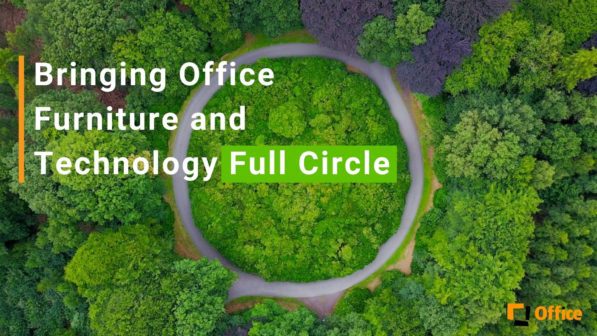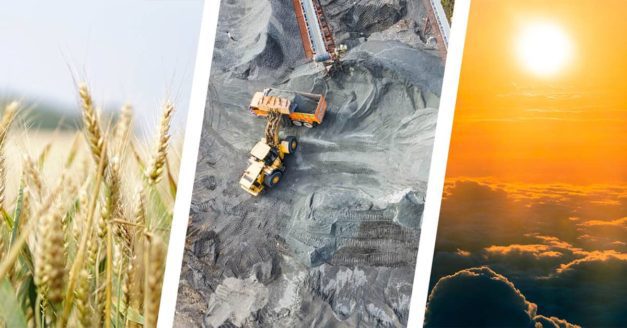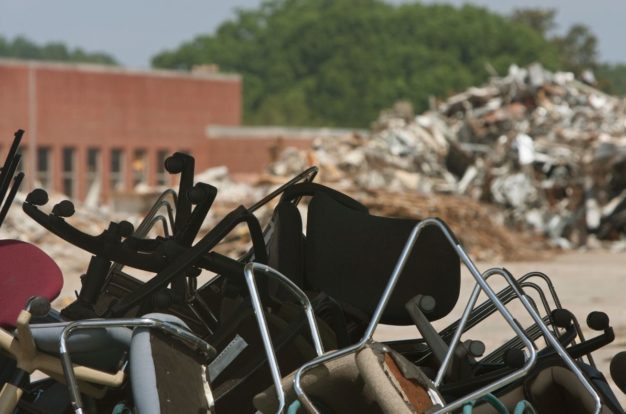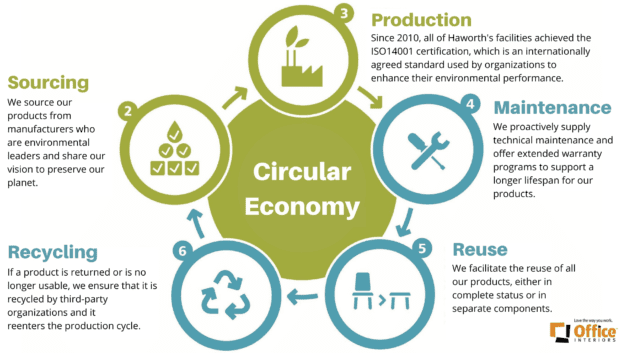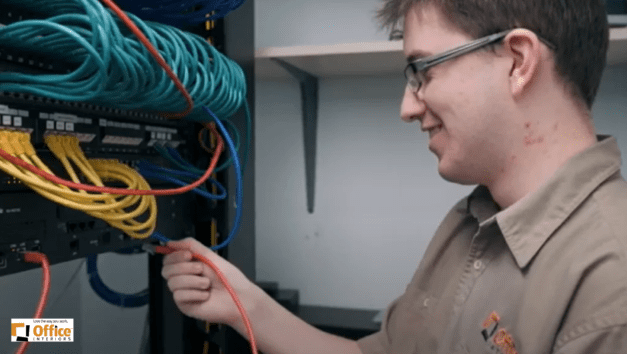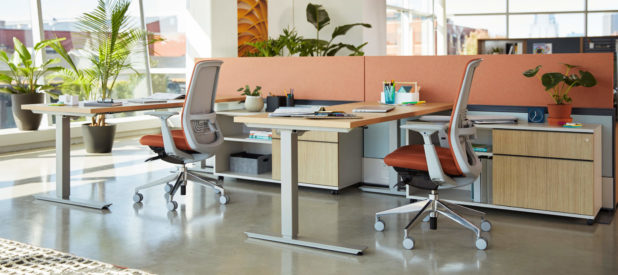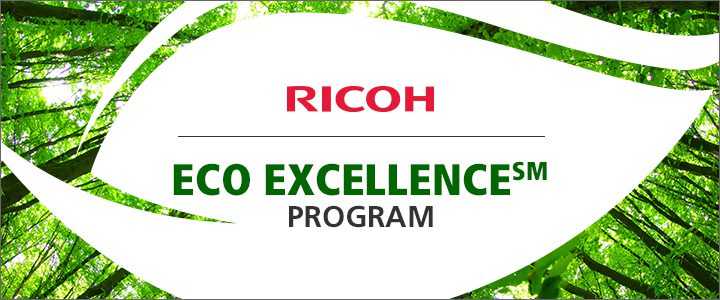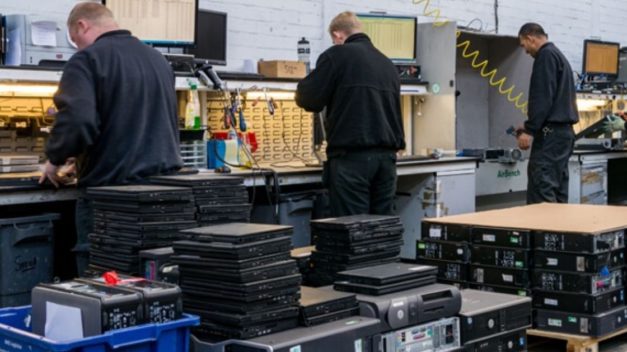Almost everything we use daily is designed to be discarded after use.
The linear path of ‘take, make, use, and dispose’ presents many social and environmental challenges – from the overconsumption of natural resources to overwhelming our environment with waste materials.
But what if we could create a solution that would eliminate the need for ‘disposing’?
Enter Circular Economy. A concept we repeatedly see in nature where all things flow in natural cycles, and there is no waste. Imagine a dead tree – while it may not be the most attractive part of a landscape, it is an important element that provides wildlife with places to nest, rest and eat, as well as rich organic material for new plants.
At Office Interiors, we follow nature’s lead by adopting processes that reduce the amount of waste generated by our operations at every possible step. This involves shifting from the long-held, linear economy to a circular economy, where materials are kept in circulation and waste is minimized.
In this article, we’ll explore what a circular economy model is, its benefits to our environment and how we’re working to close the loop.
What is a Circular Economy?
The circular economy is a system of production, consumption and waste management that is restorative and regenerative by design. It’s about ending the damaging cycle of resource extraction and consumption by encouraging organizations to reuse materials in ways that are good for people and the planet.
William McDonough first proposed the concept in 1992 as an alternative to the existing linear model of resource extraction, which he saw as unsustainable. He called it ‘the circle’ because he believed that if we could reduce our reliance on finite resources like petroleum or minerals (once thought to be inexhaustible), we would no longer be at risk from oil shortages or other resource constraints.
Today, the same concept is gaining traction in every industry as conserving our environment has become more important than ever.
How Does Circular Economy Help Our Environment?
This paradigm shift aims to create a closed-loop system that sustains a well-balanced ecological system that neither depletes nor overloads them. Here are some ways adopting a circular economy model benefits the environment:
Reduced Resource Consumption
Companies, especially those engaged in production, use a wide range of resources for their operations. The Earth’s resources, however, are only available in limited quantities, and as a consequence of the predominantly linear economic model, most of them are used only once. With our increasingly growing population, we will need more resources. According to the World Resources Institute, we will need 35% more food, 40% more water and 50% more energy in 2030. Unfortunately, existing reserves will not be able to meet the rapidly growing demand forever.
Another eye-opening insight brought forward by WWF is the ‘World Overshoot’ day, which is the date when consumption in the global economy in the given year outstrips the quantity of raw materials produced or restored yearly. This is also the day on which our use of natural resources will exceed the Earth’s capacity to regenerate them. In 2020, this day fell on the 22nd of August, but it is coming earlier every year. In essence, it’s another urgent reminder for us to adopt a circular economy so we can stop ‘borrowing’ raw materials from our future generations.
Reducing natural resource consumption is core to the circular economy concept, and it can potentially decrease our use of these resources by up to 70%.
Fewer Greenhouse Gases
The Circularity Gap Report 2021 by Circular Economy explains that if we continue business-as-usual, we will emit 65 billion tonnes of Green House Gas Emissions (GHGs) in 2030. On the other hand, by implementing circular economy principles (such as leveraging material technology to create new versions of plastic with lower carbon emissions), we could reduce global greenhouse gas emissions by 30% by 2032.
Reduced Waste in Landfills
Over 10 million tons of furniture waste end up in landfills annually in Canada and the United States. A circular economic activity reduces waste as everything produced is transferred and used continuously elsewhere.
In today’s day and time, technological advances are giving us the tools we need to accelerate and ease the transition to circularity. A great example is The Internet of Things (IoT) technology that alerts us when a machine malfunctions to ensure longer lifespans through maintenance, thus preventing it from ending up in landfills.
Technological development is not only a driver of the circular economy but a solution that promotes and facilitates its implementation.
How Is Office Interiors Bringing Office Furniture and Technology Full Circle?
Numerous circular economic activities throughout our operations are helping us move towards a closed-loop system.
1. Sustainable Design
Although we are not manufacturers of office furniture or technology, we understand that sustainable design is the first step toward becoming circular. That is why we partner with manufacturers who are world leaders in environmentally friendly products, such as Haworth, Ricoh and Humanscale. These organizations consider the whole life cycle of their products, even while choosing the necessary raw materials and functions. Moreover, they strive to make their economic footprint as minimal as possible.
Learn more about our manufacturing partners’ commitment to sustainable design – browse their green certifications and their Corporate Social Responsibility (CSR) Reports by clicking here.
2. Equipment Maintenance and Repair
At Office Interiors, we offer our customers Service Level Agreements for their equipment. Maintenance is a deliberately structured, regular activity during which critical points are inspected to prevent the occurrence of malfunctions or accidents. Additionally, our Multifunction Printers (MFPs) are equipped with sensors that allow us to perform targeted maintenance based on operating data collected from the devices. These sensors are also used for our Auto Toner Fulfilment program, which automatically ships your replacement toner whenever your device is low.
Our partnership with Haworth allows us to offer our customers products that are warranted for 24-hour / 7-day use over a specified warranty period which could range from a year to a lifetime.
All the above is aligned with our efforts to help customers preserve the usefulness of their equipment through maintenance and have it restored with repairs.
3. Furniture and Equipment Leasing Options
Office Interiors customers can lease furniture and equipment instead of owning them outright. As customers opting for this option only require access to the products for a set period of time, this prevents furniture or equipment from being completely worn down to an irreparable point. Our leasing program allows us to maximize the utility of our products – high volume users can acquire new equipment, while low volume users can take advantage of refurbished inventory sufficient for their specific needs.
This ‘Product-as-a-Service’ program aims to extend the lifetime of every piece of furniture or device we manage through the ‘first life’ and give it a ‘second life’ by refurbishing and reusing, all while minimizing our environmental impact.
We resell 97% of technology equipment that is returned at the end of the lease.
4. Used Furniture and Equipment Take-Back Program
We offer customers a take-back solution for used office furniture and equipment. More specifically, we reupholster and repurpose used furniture panels. We donated over 100 wooden pallets across communities in Fredericton last year. Additionally, used technology products are reconditioned for reselling or donating to schools and charitable organizations. This initiative allows our clients to repurpose their furniture, fixtures, and electronic products, diverting the items from landfills.
Did you know? We’re Canada’s first Ricoh Eco Excellence Member. Membership in the Ricoh Eco Excellence Program is awarded only to dealers that meet key criteria — including the dealer’s track record of environmental sustainability commitment and ability to provide customers with education, awareness, program support and guidance. Click here to learn more.
5. Technology Recycling
Office Interiors runs a recycling program for all equipment sold in the Maritimes. If the equipment is not in a condition that can be refurbished for resale or donation, we will salvage any functioning (or repairable) parts from the device. Then, when we are left with no other use for the equipment, we transport the remnant to Dartmouth Metals for appropriate recycling, which consists of separating plastics, metal and even circuit boards.
Click here to learn more about our full range of recycling programs, including how we help our customers recycle their used printer toner and cartridges.
The Way Forward
We hope this article has helped shed some light on the nature of the circular economy model and learn more about how we use its tools throughout our value chain. We think it’s important to keep an eye on our impact on our environment, and we are committed to finding new ways to reduce waste without sacrificing quality or creating new waste through our actions. Our goal is to find a balance between these two ideas so we can continue to contribute towards achieving a better future for everyone – both now and in years to come!
If you have any questions or want to share your efforts of going circular with us, reach out to us here. We’d love to hear from you!
Click here to read a note from our CEO on his thoughts about sustainability.
Ahona Saha
Marketing Assistant
Office Interiors


